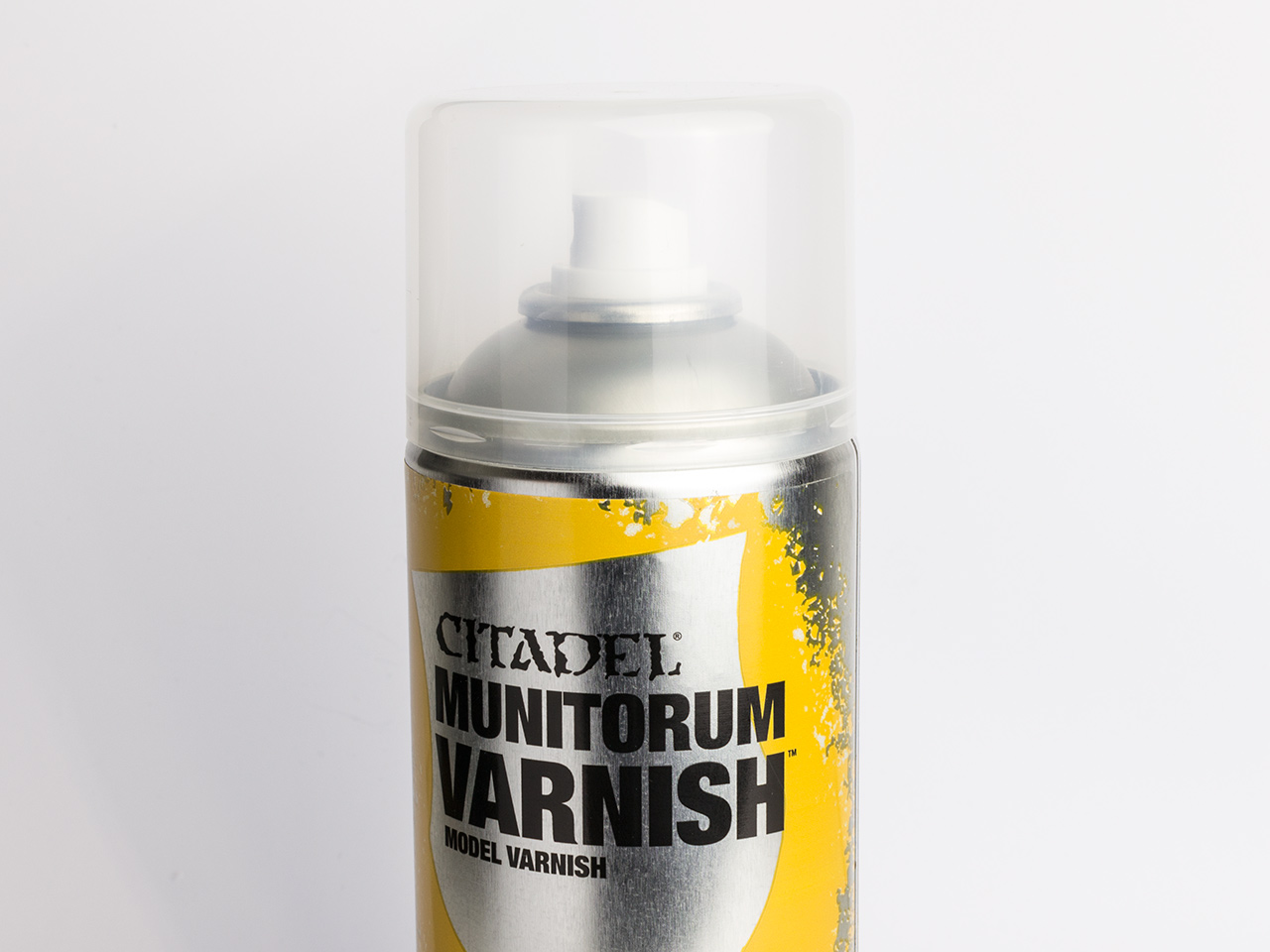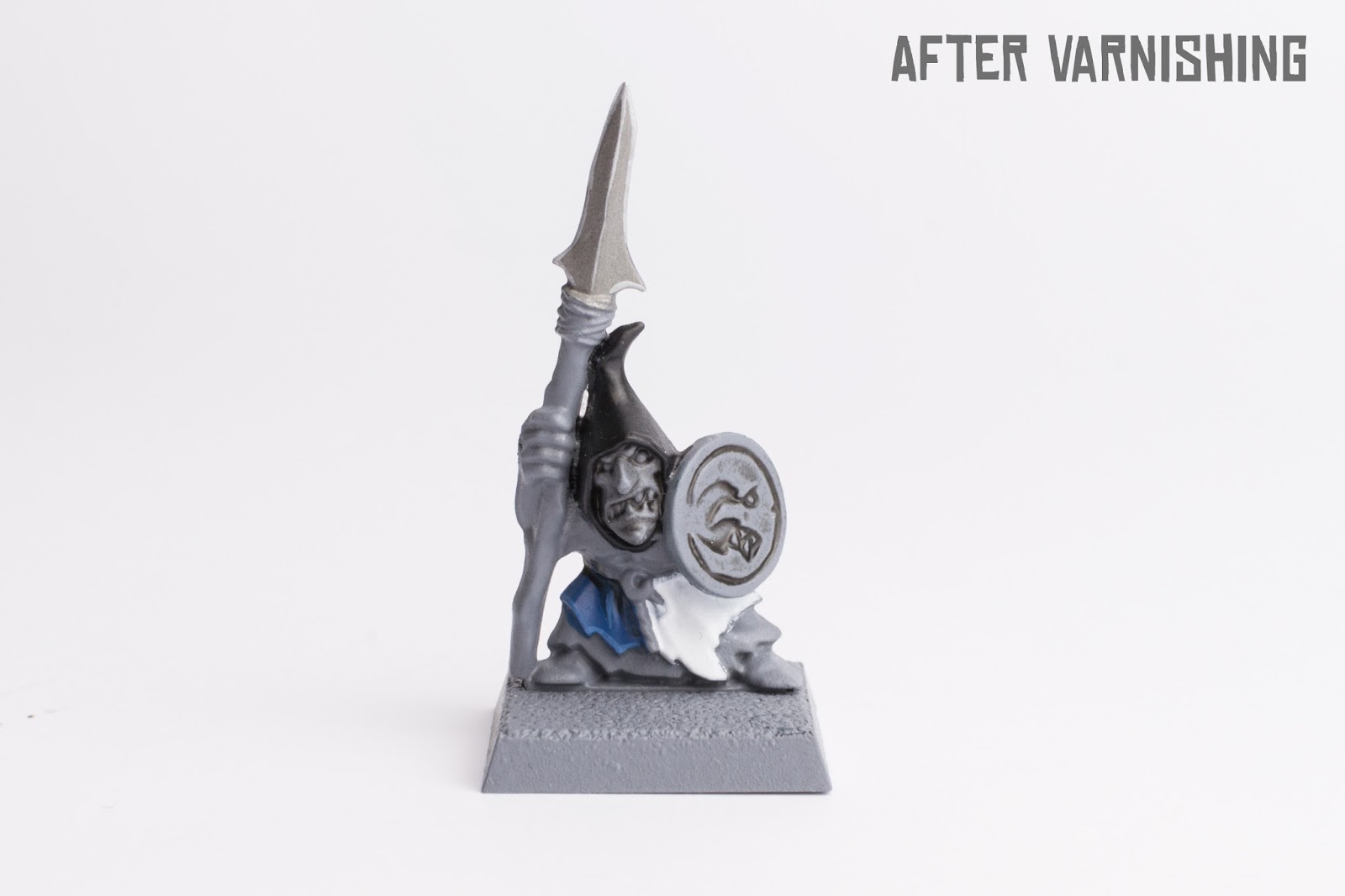Protecting your precious paint jobs is important. Even with just a moderate amount of handling, paint rubs off the edges easily. Thus, varnishing is essential. It’s surprising that it took Games Workshop so long to come up with a successor for their Purity Seal spray varnish. Munitorum Varnish is supposed to have “a semi-matt or satin finish that is very much like the natural sheen of the paint itself” – let’s see whether it lives up to its promise.


Like most of the other Citadel primers and spray paints, Munitorum Varnish comes in 400ml spray cans and is priced at £11.75/15 €/$19.75.
How to use Munitorum Varnish
Before you use the varnish, it’s a good idea to give the can a good shake for about two minutes, especially the first time you use it or when you haven’t used the can for a while. The matting agents and propellants could have separated, and the shaking ensures a proper mixing. Make sure to spray in a dry, non-humid environment. Keep the can about 20 to 30 cm away from the model, and apply a couple of short bursts from all angles. As usual, it’s better to apply two or three thin coats than one thick coat. And it’s always a good idea to test the result on an old test model first.
Games Workshop created a handy video for using Munitorum Varnish, check it out here:
Features
Old Purity Seal had a rather glossy finish, and there was the infamous batch that had a strong tendency to “frost” – drying cloudy and greyish. To put Munitorum Varnish through the paces, I prepared a test model.


The spear blade was painted with metallic paints (1), to see whether the varnish would dull the metallic pigments. The handle was painted with ‘Ardcoat (2), to see whether the varnish would remove the gloss. The hood was painted black (3), to see whether the black would become greyish after varnishing. The face was given a wash with Army Painter Dark Tone Ink (4), while the shield was washed with Nuln Oil Gloss (5). I wanted to see whether the varnish would react with the washes. The left part of the robe was painted with regular Citadel acrylics (6), while the right part of the robe was painted white (7). On the white area, we can see whether the varnish will yellow or otherwise discolour the paint job. Last but not least, there are areas of unpainted Army Painter Color Primer Uniform Grey (8). I once had a varnish that would frost on bare Pure Red Color Primer.


Here is the model after a thin coat of Munitorum Varnish. The model feels dry to the touch after just 15 minutes. As promised, it’s “a semi-matt or satin finish”. Pretty close to the natural sheen of paint ranges like Citadel, Vallejo Game Color or Formula P3. Definitely less glossy than old Purity Seal. It removed the gloss from ‘Ardcoat and Nuln Oil Gloss, while keeping the metallic effect intact. On the white robe, there is only a very slight yellowing noticeable (it’s hard to tell from the pictures, but I compared it to an unvarnished model).
On the back of the model, I sprayed on an overly thick coat of varnish. There was no frosting, just a bit of extra glossiness where the varnish pooled. But nothing another thin coat of varnish wouldn’t fix.
Conclusion
Munitorum Varnish is an excellent product that won’t ruin your miniatures. In fact, it will become my new go-to varnish, replacing the brand I used for years (a store brand by German DIY store Toom Baumarkt). It has a similar satin finish, but dries quicker and yellows less. With being easily available everywhere they sell Games Workshop products, there is no more excuse for not varnishing your models (looking at you, Garfy ;).
Update
After using my can of Munitorum Varnish a couple of times, the varnish frosted on a couple of miniatures. When you spray multiple thin coats it’s fine, but take care to not apply thick coats. The finish is still nice, but because of the danger of frosting, I can only give a limited recommendation. By the way, I removed the frost with a rubbing in olive oil.









Thanks for the olive oil tip – I had frosting on one of my minis, and was dissatisfied with the way Munitorium took the lustre off of metallics and Blood for the Blood Gods technical. The olive oil trick bought them right back to a wonderful sheen again.
Hi Eva, I had the same problem of frosting with my miniature. I managed to save my model by applying olive oil to it and gently rubbing it down, strange as it seems, but worked well. It was suggested to try on other forums ��
No change in colour after using the olive oil?
No, no problem. Baby oil might work too.
Hi, maybe someone can help me – I just used this varnish (maybe too thickly applied??) to finish my favourite dwarf and it heavily frosted 🙁
Do you know any remedy? I invested 2 days painting her and she looked just perfect…
thx
Eva
Great review thanks Stahly, I’ll have to give it a go soon!
Testors Dullcote is still my go-to for spray varnish. Always consistent quality, and the small cans are easier to shake (and mix) properly.
Unfortunately, Testors Dullcote isn't available in a lot of countries. I'd love to try it, but you can't get it in Germany.
Testors Dullcote is matt or satin finish?
Matt as in Dull for Dullcote ;-D
Just noticed mine doesn't seem to cover gloss varnish all of a sudden, it doesn't stick and sort of dries in patches :/
How do you know it yellows less if you have just started using it?
I was not talking about yellowing over time, but the discoloration that comes just from varnishing. Most varnishes aren't 100% transparent, it's just hardly noticable unless you varnish pure white.
I do not like the idea of using spray cans of any sort during the UK winters. Varnisning by brush is what I do and at no time I feel unsure about the results. After a very bad resut with a citadel spray primer that ruined the mini I will never risky it again, specially with a varnish.
model masters matte is good through the airbrush too and can be brushed on.
I cannot find this. Is it "TESTORS DULLCOTE FLAT LACQUER" that's in a little jar? Thanks
Worth mentioning that you should always invert the can and spray until only propellant comes out to clean the nozzle, especially important with varnishes.
Also frosting when varninshing on top of AP primers tends to be from the propellant they use, you need to leave the mini stand for ideally 24hours after spraying to de-gas (the same is true if you use there wood stain, sorry i mean dip ;)) was one of the biggest tips i got from them at the army painter painter weekend they did with beasts of war…, so if your following their technique you need to give it a minimum of 12hours before you varnish.
All spray varnishes are also very susceptible to moisture in the atmosphere, so never spray on a rainy day…
for those reasons ive found investing a in a cheap airbrush setup invaluable as you can do everything indoors, dont have to deal with the smell and have a far greater choice of primers and varnishes…
I remain skeptical. The only sealer that has never betrayed me is testors dulcote. All others are suspect in my eyes -_-
Thought for the day:
Trust no one, they will all betray you =][=
I’ll wait for evidence this doesn’t frost easily before changing from Army Painter range, time will tell. Looks nice finish tho, Satin suits Grey Knights when Matt is too flat. AP Aegis Suit is a Satin one too.